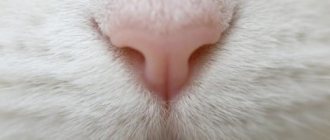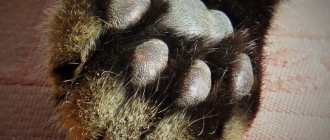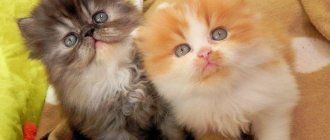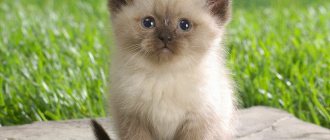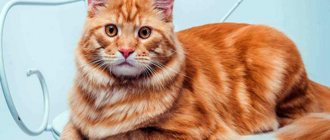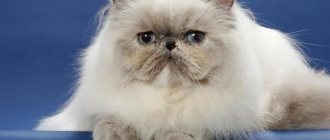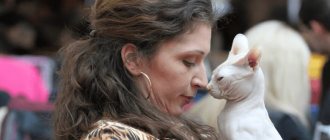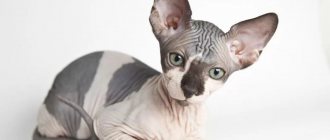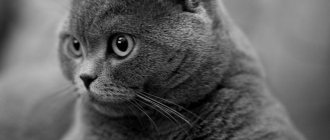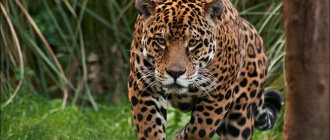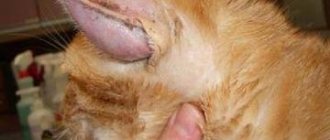Russian blue
A slender, muscular cat of medium size, on high legs, with a proportional wedge-shaped head and high-set ears. The calling card of the breed is its unique color, blue with silver tipping (lightened hair tips). It feels like the cat's coat is dusted with snow. She looks absolutely stunning with bright green eyes! The coat of Russian Blues is short and very thick - according to the standard, the hairs should be located vertically to the skin.
The history of the breed (like many other old breeds) is complex and somewhat confusing. But it is known that neither Russians nor modern Russian breeders have anything to do with its creation. These cats were bred at the beginning of the last century in Great Britain - based on animals imported from Arkhangelsk. At least that's what the most common version says. However, cats from other regions and representatives of other breeds were also involved in selection.
The nature and character of gray representatives
Males and cats of gray color are real dark cardinals among their kind. They are balanced, calm and dignified. They do not accept familiarity and prolonged active play. These animals forgive humans a lot, but only when they feel the love and care of their owner. If gray cats decide to take revenge, they “plan” it carefully and carry out vengeful actions with a time delay.
Nibelung
Gray breeds are suitable for those who value comfort and a measured life. Gray cats rarely play with children. They like to observe rather than participate. And with their behavior they resemble aristocrats.
Many breeders note the high intelligence of gray cats. Such animals love to be leaders, but they rule softly; if necessary, they prefer to retreat in order to maintain their own calm. Breeds with ash and steel tones will appeal to bachelors, elderly people, and those who lead a measured lifestyle.
Nibelung
Nibelungs are called the long-haired version of the Russian Blue, since representatives of this breed were actively involved in their selection. Indeed, their appearance is similar, and the tips of the Nibelung's hairs also have silver tipping. But there are also differences. First of all, it is long (more precisely, semi-long) thick fur, more developed muscles, and not such a bright eye color. This is a smart, good-natured and affectionate cat.
Despite the obvious relationship, the “founding fathers” of the breed were ordinary mongrel cats that were born in the United States in the 80s of the last century. Their owner logically reasoned that her unusual animals were worthy of the attention of the geneticists of the TICA felinological system. Indeed, she managed to interest specialists, and a decision was made to create a new breed. It received a beautiful legendary name for two reasons. The word "Nebel" means "fog" in German, which suits her appearance very well. And of course, in honor of the famous German epic.
American Curl
These animals were bred by pure chance. In 1981, in one of the American states, breeders selected a cat with unusual curling ears. Soon after this, she gave birth to two babies, who inherited her unusual appearance. It was these kittens that became the ancestors of the American Curls. This breed received official recognition in 1986 and quickly gained popularity among professional felinologists.
American Curls are cats with a strong body, straight limbs and well-developed muscles. On the proportional wedge-shaped head are elliptical eyes and high-set, backward-curved ears. The rectangular body of these animals is covered with short or semi-long hair. Among the representatives of this breed of gray cat with blue eyes, there are often individuals of other colors. But this is the most common color. As for character, American Curls are very inquisitive and playful. They have a natural sense of tact and innate accuracy. These good-natured, cute creatures get along well with other pets, including birds and small rodents.
Chartreuse
This is a large, strong, muscular cat, with a rounded head, small ears, large expressive eyes of yellow or copper color, and a pleasant, friendly expression on its cheeky face. The coat of the Chartreuse (exclusively blue) is short and very thick. Chartreux are naturally trained, calm, observant and affectionate. As a rule, they choose their favorite from the family, but find a common language with everyone.
This breed was bred on the basis of cats that appeared on the territory of France during the Middle Ages - it is generally believed that the Crusaders brought them with them. Their homeland is the mountains of Turkey and Iran with very harsh living conditions, which explains their extremely thick fur and excellent hunting skills. This is one of the oldest European cat breeds, the pride of French felinology, it was bred at the beginning of the last century.
Scottish fold cat
The large gray cat breed, originally from Great Britain, is a young breed, but its worldwide fame and popularity can no longer be denied.
The breed was formed in the 1960s and inherited from the British breed a thick coat and a phlegmatic character. The only serious difference is, perhaps, in the shape of the ears; otherwise the breeds are very similar.
The Scottish Fold is friendly and trouble-free. The owner needs to go to work - let him go, the owner is at home all day - that’s also normal. Of course, a cat loves its family, but it is so self-sufficient that the constant presence of a person will not make it happier; it is enough to pay attention to the cat in the evenings and a little in the morning so that the animal does not go wild in conditions of complete loneliness.
INTERESTING: the breed loves to get into a meerkat pose in moments of increased interest. The breed also does not like heights, which is very important if you have a rich interior and many shelves with souvenirs and interior decorations - all this will remain untouched, because this breed only needs to climb onto a soft sofa and is not at all interested in jumping on curtains and cabinets.
The breed's coat can be any color, but gray is the classic color that comes from the British Shorthair breed.
Korat
An elegant, medium-sized cat, flexible, strong, muscular but not ponderous, with an amazing heart-shaped head, shiny short fur with a thin undercoat and olive green eyes. Korats have a very lively, sociable character, they do not like loneliness and love to take part in all household chores.
The homeland of Korats is northern Thailand. These cats have been known for hundreds of years and were mentioned in the famous Thai treatise on cats. Korats were brought to Europe more than a hundred years ago, but breeders were not interested. Moreover, they were called a “breeding marriage of Siamese.” Only in the middle of the last century, American breeders imported several cats from Thailand and developed a breeding program to develop a new breed.
Who should get a gray cat?
The smoky cat is an animal that brings peace, luck and success to its owner, so anyone can keep it at home. However, there are several categories of people who will especially benefit from living with this furry neighbor.
Gray cats are desirable companions for anyone who plans to start their own business or open a trading business. It is believed that this animal has a mystical ability to increase wealth, so the smoky cat can be an excellent talisman for a businessman.
Silver-gray cats are able to ward off bad luck from their owners, which is why they are recommended for everyone who often has to face danger in their line of work.
Ash-colored cats have a special energy, thanks to which blood pressure can return to normal. It is recommended to have such pets for people who suffer from cardiovascular diseases and nervous disorders.
Getting a blue cat can be recommended for pregnant women and young mothers. It is believed that such a pet can harmonize feminine energy, due to which childbirth is successful and children grow up calm and healthy.
It is best to choose the nuances of your pet’s color based on your personality traits. Unbalanced and eccentric people are recommended to choose plain smoky cats - they have the ability to balance the restless energy of the owner.
Tabby gray cats, otherwise known as tabbies, help passive and insecure people gain a boost of determination and vigor.
Maine Coon
The Gulliver cat cannot be confused with any other breed. A long body, high strong legs, powerful paws, a luxurious tail, lynx tufts on the tips of the ears and, of course, an indescribable expression on the face, serious and good-natured at the same time. The Maine Coon's coat is not very thick, but it is quite long. Breed standards allow many colors. And there is no doubt that a blue Maine Coon (like any other) looks very stylish! These are smart, playful, sociable, but unobtrusive cats.
The Maine Coon is one of the most famous, recognizable and popular breeds bred by American breeders. However, selection, in the modern sense, began only in the middle of the last century. Meanwhile, evidence of the existence of these cats dates back to the middle of the 20th century: the first known Maine Coon made a splash at a country fair, striking the public with its impressive size and shaggy appearance.
Ocicat
The name of the breed is a reference to ocelots, but in fact, a young breed of blue-gray cats was developed from Abyssinian, Siamese and American Shorthair cats. The experiment was successful and the world saw a beautiful cat with a color like a wild ocelot, but gentle habits and a great love for her family.
A big plus of the breed is its great attachment to home and habits similar to those of a dog. If you take up raising and training a kitten, then walking on a harness and playing with a ball can become your constant entertainment with your pet.
The breed's disadvantages are associated with recessive genetic diseases that have accumulated as a result of selection. Most of them are inherited from Siamese blood and are complicated by the fact that the cat may not get sick for some time, but under a number of circumstances, the hereditary disease can “wake up” and the cat will die due to the transience of the disease.
The breed is not picky when it comes to grooming, but its teeth require especially close care – the enamel is prone to destruction and it’s not worth leaving plaque on the furry’s teeth.
The most common colors: brown and chocolate shades, lilac, blue and all pairs with blue from chocolate-silver to blue-silver. The hair is always ticked, and the markings on the body vary in saturation depending on where they are located.
British shorthair and longhair
It would be unforgivable to forget about the Briton - with his magnificent, thick double coat of “untwisted” blue color and amber eyes! Most cat lovers perceive them in this color variation. Meanwhile, this massive, but compact, well-proportioned cat with an important expression on her cheeky face can be of almost any color - no less spectacular than blue!
The British are one of the most famous and popular breeds bred in the UK. Persians were involved in selection (this was required after World War II, when the breed was on the verge of extinction). The long Persian coat gene has been making itself felt for many generations. Long-haired kittens were not born very rarely, but were considered a breed defect. However, they were beautiful, and enthusiasts decided to form a standard for a new breed.
Blue and smoky colors are allowed by many breed standards, but are rare in most cases. In addition, these are one of the most capricious colors of a cat's fur coat - if not the most capricious. The fact is that the quality of color is affected not only by age (in all older animals the fur coat somewhat loses its beauty), but also by sunlight, as well as nutrition. Intensely colored food gives it a dirty tint.
Didn't find what you were looking for? Use the site search form
Common Breeds
Blue coat color is required only for some breeds. Usually all its representatives have bright green eyes; very rarely they can be of a topaz shade.
| Name | Description |
| Korat | Sociable, energetic and talkative small pets. The short blue coat has no undercoat and lies close to the body. |
| Chartreuse | A very beautiful animal with short and seemingly printed hair. But he has a rather capricious and jealous character. |
| Russian blue | One of the oldest cat breeds in the Arkhangelsk province. These pets are distinguished by their silence, restraint and deep love for people. Still one of the most popular varieties. |
| Nibelung | “Child of the Mists” is very similar to the Russian Blue in its behavior and appearance. They only have beautiful and shiny wool of the semi-long type. They differ in that they meow silently. They are almost never found in Russia. One of the most sought after and beloved animals in the world. |
Cat breeds in which gray coloring is not required, but is one of the main ones:
| Name | Description |
| British Shorthair | There are more than 200 shades, the main one being gray in various tones. An uneven color distribution, presence of patterns, blue tabby, chinchilla, shaded color are considered defective. Temperamentally well-mannered, unobtrusive, independent. They tolerate loneliness calmly. Therefore, they can be given to people who are often absent. |
| Scottish lop-eared | A defect is considered to be uneven coloring of the wool, colored inclusions. The color is blue marble, silver chinchilla. They are friendly with children and other pets. Mobile, friendly, unobtrusive. |
| Persian | Light-colored wool with uniform coloring along the entire length. Blue marble, solid lilac, bluish-smoky colors are especially valued. Affectionate, gentle, but spoiled. Requires constant attention. |
| Turkish Angora | The blue color of the breed was recently developed. Light colors are preferable. The hair at the base is darker. The paw pads and nose match the coat color. They prefer solitude and are calm. Suitable for people leading a sedentary lifestyle. |
| American Curl | It is characterized by a rich gray color: silver tabbies with marbled and spotted streaks, blue smoky and others. Curious and devoted. They lead an active lifestyle and prefer frisky games. They love the company of children and treat other pets well. |
| Ragamuffin | Light inclusions in color are acceptable. Yellow eyes and green irises are considered a marriage. Affectionate, balanced, friendly. They are devoted to their owners, love children, and get along with other animals. |
| Egyptian Mau | Silver-smoky color with a spotted pattern. He has a closed character and does not trust strangers. |
| Oriental | Thin, graceful with a long tail. They have slanted eyes. Usually do not cause allergies. |
| Ocicat | The color is varied: from cream to blue. There are spots all over the body. Because of them they resemble a wild ocelot. |
| Abyssinian | Descended from ancient Egyptian cats. The Abyssinian has a slender, muscular body, arched neck and large ears. |
| Australian smoke | Wool has three components: background, dark pattern, haze. There are marbled and spotted colors with spots and stripes. Friendly, affectionate. They are good with children and other pets. Rarely scratch or bite. Trainable. |
| Asian smoky | Belongs to the smooth-haired breed. There is a light undercoat. The eyes are amber or yellow. They cannot stand loneliness and crowded conditions. Calm, affectionate, obedient. They know how to express gratitude. |
| British Longhair | They appear fluffy due to their thick undercoat and short limbs. The Briton has a large muzzle with large cheeks and rounded eyes. Obedient, calm. They tolerate separation from their owners well. |
| Bramble | The fur coat is rough, reminiscent of a dog's. The body is strong with a long tail. The ears are large, the eyes are almond-shaped. Affectionate and playful. They are easy to train and have a pronounced hunting instinct. They communicate with all household members, but choose one owner. |
| California radiant | They have leopard print on a yellow or silver background. The coat is pleasant to the touch, short. Conflicts are not typical for the breed. Calm and friendly. |
| Gobi gray | This is a wild animal, not a breed. In summer, the cat is grayish-yellow. In winter - gray-brown. There are subtle stripes and spots along the body. |
| American Bobtail | A special feature is the movable shortened tail. The breed has a strong body and a square head. The most common color is agouti. The pet prefers noisy companies. Perfect for large families. |
| Norwegian forest | Large, muscular with elongated legs. The wool is water-repellent with a pronounced collar and “pants”. Obedient, tolerant of children and other animals. |
| Ojos Azules | The color of the fur coat has more than three hundred shades (including gray). Bright blue eyes of medium size stand out on the muzzle. They learn commands easily and are intelligent. They don't like noisy children. |
